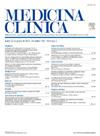Metabolic profiles of Turner syndrome: A real-world cohort study
IF 2.1
4区 医学
Q1 MEDICINE, GENERAL & INTERNAL
引用次数: 0
Abstract
Background and objective
Turner syndrome (TS), primarily characterized by premature ovarian insufficiency, is a disease resulting from a complete or partial absence of the second X chromosome. This study aims to describe the prevalence of metabolic comorbidities in TS patients of different ages and karyotypes.
Methods
The medical history, diagnosis, physical examination, laboratory examination and imaging examination data of 145 TS patients were obtained from the medical files.
Results
(1) In total, 4.1% of the TS patients in this cohort were diagnosed with hypertension, and elderly patients had higher blood pressure. (2) 6.9% of patients were diagnosed with diabetes, and monosomic TS had a lower TyG index. (3) The prevalence of dyslipidemia and fatty liver was 20.0% and 16.7% respectively. TS patients treated with recombinant human growth hormone (rhGH) had significantly higher LDL-C and Apo-A1 levels. (4) The prevalence of hyperuricemia was 27.6%, and higher uric acid levels were observed in young patients and those receiving rhGH treatment. A total of 17.2% of patients were diagnosed with liver dysfunction. (5) The prevalence of low bone mass, which was higher in elderly patients and those without rhGH treatment, was 53.8% in TS patients older than 19 years.
Conclusions
TS patients have a higher prevalence of metabolic comorbidities, including dyslipidemia, fatty liver, hyperuricemia, liver dysfunction and low bone mass. RhGH treatment in childhood had some positive effects on glucose, lipid and bone metabolism in young adulthood. Therefore, additional attention should be given to metabolic comorbidities in TS patients at high risk.
特纳综合征的代谢概况:一项真实世界的队列研究
背景与目的特纳综合征(TS)是一种由第二条X染色体完全或部分缺失引起的疾病,主要以卵巢功能不全为特征。本研究旨在描述不同年龄和核型的TS患者代谢合并症的患病率。方法从医疗档案中获取145例TS患者的病史、诊断、体格检查、实验室检查和影像学检查资料。结果(1)本组TS患者中,诊断为高血压的占4.1%,老年患者血压较高。(2) 6.9%的患者诊断为糖尿病,且单体TS的TyG指数较低。(3)血脂异常和脂肪肝患病率分别为20.0%和16.7%。接受重组人生长激素(rhGH)治疗的TS患者LDL-C和Apo-A1水平显著升高。(4)高尿酸血症的患病率为27.6%,其中年轻患者和接受rhGH治疗的患者尿酸水平较高。共有17.2%的患者被诊断为肝功能障碍。(5)年龄大于19岁的TS患者低骨量患病率为53.8%,在老年患者和未接受rhGH治疗的患者中较高。结论sts患者有较高的代谢合并症患病率,包括血脂异常、脂肪肝、高尿酸血症、肝功能障碍和低骨量。儿童期RhGH治疗对青年期的糖、脂和骨代谢有一定的积极作用。因此,应额外关注高危TS患者的代谢合并症。
本文章由计算机程序翻译,如有差异,请以英文原文为准。
求助全文
约1分钟内获得全文
求助全文
来源期刊

Medicina Clinica
医学-医学:内科
CiteScore
3.10
自引率
5.10%
发文量
295
审稿时长
22 days
期刊介绍:
Medicina Clínica, fundada en 1943, es una publicación quincenal dedicada a la promoción de la investigación y de la práctica clínica entre los especialistas de la medicina interna, así como otras especialidades. Son características fundamentales de esta publicación el rigor científico y metodológico de sus artículos, la actualidad de los temas y, sobre todo, su sentido práctico, buscando siempre que la información sea de la mayor utilidad en la práctica clínica.
 求助内容:
求助内容: 应助结果提醒方式:
应助结果提醒方式:


